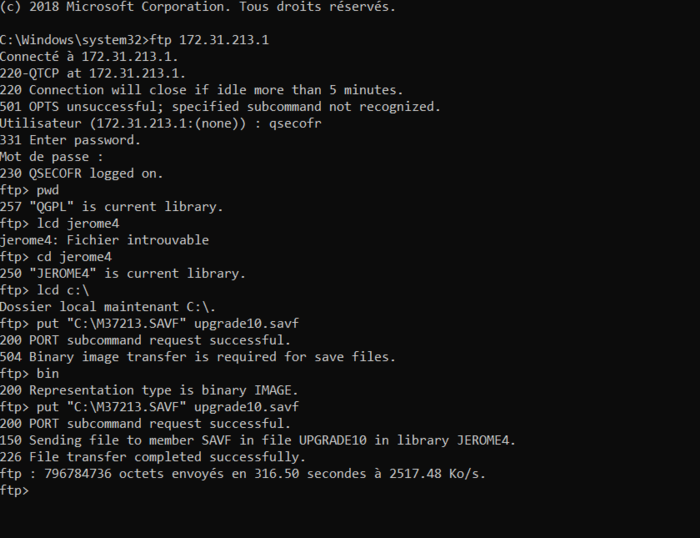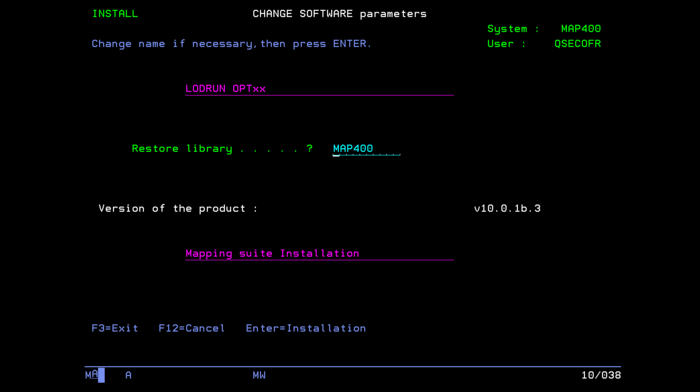OPALE - 10.0 - Installation
Installing OPALE Server
Sommaire
- 1 Pré-requis
- 2 Update or installation procedure
- 3 Software activation
- 4 Vérification après installation
Pré-requis
Ce guide décrit les procédures d’installation et de mise à jour du produit OPALE Server sur un système IBM i.
Pour rappel, il est recommandé de mettre à jour les autres modules de la solution Mapping en même temps. Cela afin d'éviter toute erreur de compatibilité.
Système
Configuration minimale requise :
- OS/400 V7R1 ou supérieur
- 2 Go d’espace disque
- Connexion FTP
En cas de mise à jour de M-Processing Server :
- Se référer au process d'upgrade/migration : Process d'upgrade/Migration
Remarque : Sur OS/400 V7R1 et supérieur, les versions de M-Processing Server antérieures à la 7.1 ne sont pas compatibles avec Opale.
Sécurité
The QSECOFR profile is required to install the software.
Update or installation procedure
Update information
Please refer to the : Upgrade Process
Preparation
The software installation program can be downloaded from the Mapping Suite technical server at https://server.mappingsuite.com.
It is called setup_Opale_vXX.X.X.XXXXX.zip.
After downloading and uncompressing, it can safely be renamed to MXXXXX.SAVF.
Installing or updating by FTP
Creating the restore SAVF
Run this command:
CRTSAVF FILE(QGPL/MXXXXX)
Transferring and creating content from the library
There are 3 solutions
- Transferring the file MXXXXX.SAVF via FTP to the previously created library. (Recommanded)
- Transferring the file MXXXXX.SAVF via SCP to the previously created library.
However, it is also possible to transfer the ZIP archive and afterwards:
- to extract the archive directly from the previously created library.
Transferring FTP from the SAVF to the IBM i system
Transferring the MXXXXX.SAVF to the created library.
- Under Windows in Start/Programs, choose MS-DOS Command Prompt
- Go to the folder where the file you have just downloaded is saved e.g. CD My documents\Mapping
- Enter ftp "AS400 IP address" (no quotes) e.g. ftp 9.5.5.3
- And then sign in on the IBM i
- Enter binary
- Enter cd qgpl (or the library of the savf file you have created)
- Enter put MXXXXX.savf
- … (the file is being transferred and then you regain control)
- Enter close
- Then quit
- And then exit
Then, skip to Restoring the SAVF.
SSH Transfer to the IFS
If the IBM has its SSH server configured.
Transfer the SAVF file (or the ZIP file) using the SCP protocol (e.g. using WinSCP) to a folder on the IFS.
scp MXXXXX.SAVF user@as400:/QSYS.LIB/QGPL.LIB
Then, skip to Restoring the SAVF.
Extracting the SAVF from the IFS
If the ZIP has been transfered to the AS, the jar tool allows you to unzip archives, under qsh.
The extracted file should be MXXXXX.SAVF :
jar xf setup_Opale_server_v10.0.2.XXXXX.zip cp MXXXXX.SAVF /QSYS.LIB/QGPL.LIB/MXXXXX.FILE
Then skip to Restoring the SAVF.
Restoring the SAVF
Run this command:
RSTOBJ OBJ(*ALL) SAVLIB(QTEMP) DEV(*SAVF) SAVF(QGPL/MXXXXX)
Launch the installation script
Run this command:
CALL PGM(QTEMP/RUNSETUP)
Installation steps
Enter the name of the library you want to install or update.
Caution : Whether this is a new install or an upgrade, do not use a production library. Please refer to the Upgrade process
You will need to specify the:
- Sub-system name (the sub-system is created in the library where the product is restored)
- Installation folders
- System LANGID and code page
Note: The code page must always be 4 digits. Example 0037 or 0500.
example of a code page:
0297: French without the euro € symbol
1147: French with the Euro € symbol
After that if you are installing the product, you will need to enter the software activation codes called software keys. If you do not do it now, you can do it later by running the MAPKEY command. See Software Activation. If you are updating the product or do not have the software activation keys now, press F3 to skip.
Installation is complete when the following screen is displayed. Press Enter to continue.
Note: After installing and before using the product, you will need to end the session and sign back in.
Langage
The screens of the Mapping menu can be displayed in the following languages:
- French: MAPMSGFRA
- English: MAPMSGENU
- Japanese: MAPMSGJPN
The language is specified in the environment settings (Language File + Language ID).
Menu Mapping (enter the command GO MAPPING), option 14 then option 1.
or from the general Mapping menu: Operations menu / General Parameters
Otherwise, from the OPALE menu, choose Operations and then "Mapping Environment Parameters"
Code pages
Supported code pages
| Code | Codepage | ISO | Nom | Fichier |
|---|---|---|---|---|
| AFR | (037) | {latin1:1252} | Afrikaans | [Q037_19U-Q19U_037] |
| BEL | (1025,1154) | {Russian:1251} | Byelorussian | [Q1154_9R-Q9R-1154] |
| BGR | (1025,1154) | {Russian:1251} | Bulgarian | [Q1154_9R-Q9R-1154] |
| CSY | (0870,1153) | {latin2:1250} | Czech | [Q1153_9E-Q9E_1153] |
| DES | (0500) | {latin1:1252} | Swiss German | [Q1141_19U-Q19U_1141] |
| DEU | (0273,1141) | {latin1:1252} | German | [Q1141_19U-Q19U_1141] |
| CHS | {0836} | {s.chinese:00935} | Simplified Chinese | [Q013_19U-Q19U_037- S_Chinese_base1993.tbl] |
| CHT | {0037} | {t.chinese:00937} | Traditional Chinese | [Q013_19U-Q19U_037- T_Chinese_base1999.tbl] |
| ELL | (0875) | {Greek:1253} | Greek | [Q875_9G-Q9G_875] |
| ENA | (037) | {latin1:1252} | Australian English | [Q037_19U-Q19U_037] |
| ENG | (0285,1146) | {latin1:1252} | United Kingdom English | [Q285_19U-Q19U_285] |
| ENP | (037) | {latin1:1252} | Uppercase English | [Q037_19U-Q19U_037] |
| ENU | (037) | {latin1:1252} | United States English | [Q037_19U-Q19U_037] |
| ESP | (0284,1145) | {latin1:1252} | Spanish | [Q1145_19U-Q19U_1145] |
| FRA | (0297,1147) | {latin1:1252} | French | [Q1147_19U-Q19U_1147] |
| FRB | (0500,1148) | {latin1:1252} | Belgian French | [Q1148_19U-Q19U_1148] |
| FRC | (0500) | {latin1:1252} | Canadian French | [Q1148_19U-Q19U_1148] |
| FRS | (0500) | {latin1:1252} | Swiss French | [Q1148_19U-Q19U_1148] |
| GAE | (0285,1146) | {latin1:1252} | Irish Gaelic | [Q285_19U-Q19U_285] |
| HRV | (0870,1153) | {latin2:1250} | Croatian | [Q1153_9E-Q9E_1153] |
| HUN | (0870,1153) | {latin2:1250} | Hungarian | [Q1153_9E-Q9E_1153] |
| ITA | (0280,1144) | {latin1:1252} | Italian | [Q1144_19U-Q19U_1144] |
| ITS | (0500) | {latin1:1252} | Swiss Italian | [Q1148_19U-Q19U_1148] |
| JPN | {0290} | {Japanese:05026} | Japanese Katakana | [Q013_19U-Q19U_037- Japanese_base1996.tbl] |
| KOR | {0833} | {Korean:00933} | Korean | [Q013_19U-Q19U_037- Korean_base1992.tbl] |
| MKD | (1025,1154) | {Russian:1251} | Macedonian | [Q1154_9R-Q9R-1154] |
| NLB | (0500,1148) | {latin1:1252) | Belgian Dutch | [Q1148_19U-Q19U_1148] |
| NLD | (037,1140) | {latin1:1252} | Dutch | [Q037_19U-Q19U_037] |
| PLK | (0870,1153) | {latin2:1250} | Polish | [Q1153_9E-Q9E_1153] |
| PTB | (037) | {latin1:1252} | Brazilian Portuguese | [Q037_19U-Q19U_037] |
| PTG | (037,1140) | {latin1:1252} | Portuguese | [Q037_19U-Q19U_037] |
| ROM | (0870,1153) | {latin2:1250} | Romanian | [Q1153_9E-Q9E_1153] |
| RUS | (1025,1154) | {Russian:1251} | Russian | [Q1154_9R-Q9R_1154] |
| SKY | (0870,1153) | {latin2:1250} | Slovakian | [Q1153_9E-Q9E_1153] |
| SLO | (0870,1153) | {latin2:1250} | Slovenian | [Q1153_9E-Q9E_1153] |
| SQI | (0500) | {latin1:1252} | Albanian | [Q1148_19U-Q19U_1148] |
| SRB | (1025,1154) | {Russian:1251} | Serbian Cyrillic | [Q1154_9R-Q9R-1154] |
| SRL | (0870,1153) | {latin2:1250} | Serbian Latin | [Q1153_9E-Q9E_1153] |
| TRK | (1026,1155) | {Turkish:1254} | Turkish | [Q1155_5T-Q5T_1155] |
| THA | {0838} | {Thai :874} | Thai | [Q838_0T-Q0T_383] |
Unsupported code pages
| Code | Codepage | Nom |
|---|---|---|
| ARA | 0420 | Arabic |
| CAT | 0284 | Catalan |
| DAN | 0277 | Danish |
| FAR | 1097 | Farsi |
| FIN | 0278 | Finnish |
| HEB | 0424 | None Hebrew |
| ISL | 0871 1149 | Icelandic |
| NON | 0277 | Norwegian Nynorsk |
| NOR | 0277 | Norwegian Bokmal |
| SVE | 0278 | Swedish |
Software activation
After installing the software, you will need to enter activation codes called license keys. The license keys are hardware-dependent. To obtain the license keys for your system, you will need to:
- Retrieve the system id
- Contact Technical Support, or log on to http://server.mappingsuite.com
Note: If the license keys are not entered, some screens in the Mapping menu cannot be accessed.
Server ID
Run the MAPKEY command to retrieve the information needed to generate your license keys.
Write down the information below and then press F3 to exit.
- Serial Number
- Model Number
- Processor Type
Entering the licence keys
Le nombre de clés de licence requises dépend des options achetées.
Pour chaque clé, exécuter la commande MAPKEY et saisir le numéro du produit associé à la clé, puis appuyer sur Entrée pour valider.
Remarque : Si la clé saisie est correcte, l’écran suivant s’affiche. Sinon, la clé est mise en surbrillance comme illustré ci-dessous :
Vérification après installation
Ce chapitre est conçu pour vous aider à contrôler que le processus d’installation s’est déroulé sans accroc et que l’environnement Mapping est configuré correctement.
Il suffit de suivre chaque étape pas à pas. Tous les points à vérifier sont listés ci-dessous.
Activation du profil utilisateur MAPPING
La première chose à faire est d’activer le profil MAPPING sur le système.
Par défaut, lors de l’installation, le profil utilisateur MAPPING est créé avec le mot de passe à blanc.
Exécuter la commande CHGUSRPRF pour définir un mot de passe pour l’utilisateur MAPPING.
Si cela n’est pas fait, vous ne pourrez pas utiliser ce profil à des fins de test.
Ce profil a toutes les autorisations nécessaires à l’utilisation du logiciel MAPPING. Il s’agit d’un profil de type *PGMR qui peut être utilisé comme bon vous semble si nécessaire.
Vérification de l’environnement MAPPING
Sur la ligne de commande, taper MAPPING pour accéder au menu principal.
Sélectionner l’option "Paramètres d'environnement Mapping" dans le menu Exploitation.
Les chemins sont affichés en bas de l’écran et les valeurs dépendent du langage système (les valeurs peuvent changer selon le système sur lequel le logiciel est installé).
Vérification de l’IFS
Il est aussi recommandé de vérifier l’IFS lui-même. La façon la plus rapide de faire cela est d’utiliser la commande WRKLNK. Dans tous les cas, les dossiers suivants doivent être présents dans l’IFS : mapout, mapping, mapreport, mapsend.
Objets système requis par le logiciel MAPPING
Pour approfondir le diagnostic, il faudrait vérifier les Job Queues et les Job Descriptions. Utiliser la commande WRKOBJ pour afficher les objets MAP* requis par le logiciel.
Les Job Queues suivantes doivent apparaitre :
MAPQFIND, MAPQMIDDLE, MAPQROBOT, MAPQSLOW, MAPQSMTP, MAPQSMTP2, MAPQSPEED, MAPQTCPIP
Les Job Descriptions suivantes doivent apparaitre :
MAPDFIND, MAPDMIDDLE, MAPDROBOT, MAPDSLOW, MAPDSMTP, MAPDSMTP2, MAPDSPEED, MAPDTCPIP
Démarrage du Robot
Démarrer le robot à l’aide de la commande STRRBT, puis afficher le sous-système à l’aide de la commande WRKSBS.









